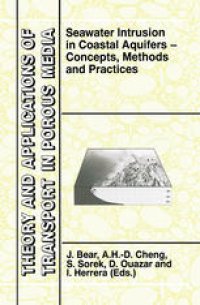
Ebook: Seawater Intrusion in Coastal Aquifers — Concepts, Methods and Practices
- Tags: Geotechnical Engineering & Applied Earth Sciences, Terrestrial Pollution, Hydrogeology
- Series: Theory and Applications of Transport in Porous Media 14
- Year: 1999
- Publisher: Springer Netherlands
- Edition: 1
- Language: English
- pdf
Coastal aquifers serve as major sources for freshwater supply in many countries around the world, especially in arid and semi-arid zones. Many coastal areas are also heavily urbanized, a fact that makes the need for freshwater even more acute. Coastal aquifers are highly sensitive to disturbances. Inappropriate management of a coastal aquifer may lead to its destruction as a source for freshwater much earlier than other aquifers which are not connected to the sea. The reason is the threat of seawater intrusion. In many coastal aquifers, intrusion of seawater has become one of the major constraints imposed on groundwater utilization. As sea water intrusion progresses, existing pumping wells, especially those close to the coast, become saline and have to be abandoned. Also, the area above the intruding seawater wedge is lost as a source of natural replenishment to the aquifer. Despite the importance of this subject, so far there does not exist a book that integrates our present knowledge of seawater intrusion, its occurrences, physical mechanism, chemistry, exploration by geo physical and geochemical techniques, conceptual and mathematical modeling, analytical and numerical solution methods, engineering measures of combating seawater intrusion, management strategies, and experience learned from case studies. By presenting this fairly comprehensive volume on the state-of-the-art of knowledge and ex perience on saltwater intrusion, we hoped to transfer this body of knowledge to the geologists, hydrologists, hydraulic engineers, water resources planners, managers, and governmental policy makers, who are engaged in the sustainable development of coastal fresh ground water resources.
This book provides a comprehensive coverage of the theories and practices of sea water intrusion in coastal aquifers, written by a select group of more than two dozen international experts. The subjects range from the fundamentals such as the physical background and the mathematical theory, to the newest technologies in geophysical and geochemical survey, monitoring, exploitation and restoration of aquifers, planning and management. For engineers, quantitative tools such as analytical solutions, numerical techniques, and stochastic analysis methodologies are provided. Several numerical codes that include two popular USGS computer programs SHARP and SUTRA, written by the original developers, and other advanced codes, are available for sharp interface and density-dependent transport modeling. Case studies include those of the USA, the Netherlands, Israel, and Egypt.
Audience: This book is well suited for students learning the subject, professionals for enrichment of new information and technologies, water resources planners for broadening their knowledge and options for combating sea water intrusion.